|
|
|
Sort Order |
|
|
|
Items / Page
|
|
|
|
|
|
|
| Srl | Item |
| 1 |
ID:
125113
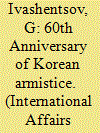

|
|
|
|
|
| Publication |
2013.
|
| Summary/Abstract |
ON JULY 27, 2013, it will be 60 years since the Armistice Agreement was signed in the village of Panmunjom, putting an end to the three-year Korean War. That war, which has become the bloodiest and most devastating military conflict since the end of World War II, remains an unhealed wound for the Koreans while its consequences are still making an impact on the international situation in Northeast Asia and beyond.
|
|
|
|
|
|
|
|
|
|
|
|
|
|
|
|
| 2 |
ID:
132793
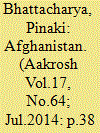

|
|
|
|
|
| Publication |
2014.
|
| Summary/Abstract |
General Boris Gromov, commander of the 40th Army of the Soviet Union, crossed the 'Friendship' bridge linking the Salang Pass on 15 February I989. hack to the motherland. Najibullah. the Afghan president and a Communist protege' of the USSR regime of Mikhail Gorbachev, was ousted from power in April 1992. The intervening three years have a story to tell to the various protagonists of the current Afghan drama being enacted right now as another superpower gets ready to decamp without completing what it set out to do. The Red Army had left in early I989, and its nominee, Najihullah. held on to power for another three years on the strength of the same Afghan army that had desertions, remained fragmented in factional lines - the Parchams and the Khalqis - and was depleted in terms of resources.
|
|
|
|
|
|
|
|
|
|
|
|
|
|
|
|
| 3 |
ID:
031746


|
|
|
|
|
| Publication |
Washington, Pergamon-Brassey's International Defense Publishers, Inc., 1989.
|
| Description |
vii, 340p.Hbk
|
| Standard Number |
0080359744
|
|
|
|
|
|
|
|
|
|
|
|
Copies: C:1/I:0,R:0,Q:0
Circulation
| Accession# | Call# | Current Location | Status | Policy | Location |
| 031309 | 940.5421/ROT 031309 | Main | On Shelf | General | |
|
|
|
|
| 4 |
ID:
153759
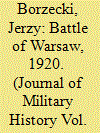

|
|
|
|
|
| Summary/Abstract |
The Battle of Warsaw decided the outcome of the Polish-Soviet War of 1919–1920. The Red Army suffered what Lenin called a “catastrophic” and “unheard-of defeat.” Historians have often found it difficult to explain the astonishing Polish victory—the “Miracle on the Vistula.” The latest English-language literature on the topic is confusing. Ian Johnson asserts the battle was won thanks to the cracking of Soviet ciphers by the Polish radio-intelligence service. Adam Zamoyski does not even mention radio-intelligence as a factor. This article resolves the problem by looking at the recent Polish literature on the subject.
|
|
|
|
|
|
|
|
|
|
|
|
|
|
|
|
| 5 |
ID:
116782
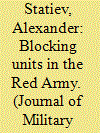

|
|
|
|
|
| Publication |
2012.
|
| Summary/Abstract |
After the German offensive toward Stalingrad began in 1942, Joseph Stalin issued Order No. 227 (the "Not a Step Back!" order), institutionalizing the blocking units that already existed in some divisions. This article examines the units and their place among the Red Army's other draconian policies. Historians interpret Order No. 227 as exceptionally harsh, yet the policies stemming from it were exceptional primarily in their methodical application rather than in their essence. A logical outcome of "the end justifies the means" Stalinist philosophy, blocking units made the army steadier and contributed to its victory. This was the only fact that mattered to the Soviet leaders, and they ignored the moral issues raised by the existence of the units.
|
|
|
|
|
|
|
|
|
|
|
|
|
|
|
|
| 6 |
ID:
039093
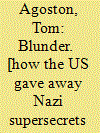

|
|
|
|
|
| Publication |
London, William Kimber & Co Ltd, 1985.
|
| Description |
176p.Hbk
|
| Standard Number |
0-7183-0617-1
|
|
|
|
|
|
|
|
|
|
|
|
Copies: C:1/I:0,R:0,Q:0
Circulation
| Accession# | Call# | Current Location | Status | Policy | Location |
| 028701 | 940.5485/AGO 028701 | Main | On Shelf | General | |
|
|
|
|
| 7 |
ID:
121534
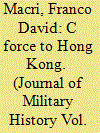

|
|
|
|
|
| Publication |
2013.
|
| Summary/Abstract |
In November 1941 two Canadian infantry battalions arrived in the British Crown Colony of Hong Kong as reinforcements for the garrison. This deployment is considered an element of Britain's effort to deter Japanese aggression south against areas more vital, but this paper will demonstrate how other significant geopolitical issues led to this event. Canadian troops were sent to Hong Kong largely because of U.S. influence. Aimed at bolstering Chinese morale, Hong Kong's reinforcement was meant to sustain the Sino-Japanese war in order to provide indirect support to the Soviet Far East when the Red Army faced destruction in Europe.
|
|
|
|
|
|
|
|
|
|
|
|
|
|
|
|
| 8 |
ID:
027806
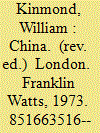

|
|
China
/ Kinmond, William
|
1973

|
|
|
|
| Edition |
rev. ed.
|
| Publication |
London, Franklin Watts, 1973.
|
| Description |
87p.hbk
|
| Standard Number |
851663516
|
|
|
|
|
|
|
|
|
|
|
|
Copies: C:1/I:0,R:0,Q:0
Circulation
| Accession# | Call# | Current Location | Status | Policy | Location |
| 011267 | 951/KIN 011267 | Main | On Shelf | General | |
|
|
|
|
| 9 |
ID:
123228
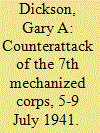

|
|
|
|
|
| Publication |
2013.
|
| Summary/Abstract |
The war between Germany and the Soviet Union witnessed some of the largest tank battles in history. Most accounts of the Russo-German war label the battle of Kursk, specifically the fighting around the village of Prokhorovka on 12 July 1943, as the largest tank battle in history. However, since the fall of the Soviet Union, more details have come out regarding other, lesser known, battles that involved even more tanks. One of these engagements was the counterattack by the Red Army's 20th Army using two of the newly created mechanized corps. During the period 5-9 July 1941, the Soviet 5th and 7th mechanized corps launched a counterattack with over 1,000 tanks against elements of two German mobile corps around the village of Senno in what is now Belarus. Almost unknown in the West and virtually ignored in the Soviet Union, study of this battle sheds light on the condition of the Red Army in the first weeks of the war and on the lessons that influenced the future development of large-scale armored formations in the Red Army.
|
|
|
|
|
|
|
|
|
|
|
|
|
|
|
|
| 10 |
ID:
189184
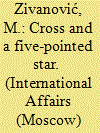

|
|
|
|
|
| Summary/Abstract |
AFTER the end of the Jassy-Chisinau operation that liberated Romania and Bulgaria in September 1944, Red Army units reached the border of the former Yugoslavia. On September 28, a major offensive began that resulted in the liberation of Belgrade on October 20. The offensive was followed by military operations to cross the Danube River and take and hold the bridgehead, known as the Battle of Batina (the biggest battle in Yugoslavia during World War II), and then battles on the Syrmian Front, which was broken in April 1945.
|
|
|
|
|
|
|
|
|
|
|
|
|
|
|
|
| 11 |
ID:
118410
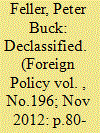

|
|
|
| 12 |
ID:
038556
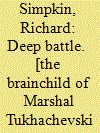

|
|
|
|
|
| Publication |
London, Brassey's Defence Publishers, 1987.
|
| Description |
xii, 281p.: ill.Hbk
|
| Standard Number |
0080311938
|
|
|
|
|
|
|
|
|
|
|
|
Copies: C:1/I:0,R:0,Q:0
Circulation
| Accession# | Call# | Current Location | Status | Policy | Location |
| 027406 | 923.547/SIM 027406 | Main | On Shelf | General | |
|
|
|
|
| 13 |
ID:
174518
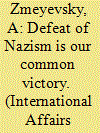

|
|
|
| 14 |
ID:
169540


|
|
|
| 15 |
ID:
133763
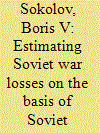

|
|
|
|
|
| Publication |
2014.
|
| Summary/Abstract |
The problem of calculating the Soviet losses in the Second World War has confronted scholars with potentially insoluble difficulties. Especially in the first year of the war, during the catastrophic defeats and disorganized retreats, individual records on Soviet military personnel were either simply not kept or were lost or destroyed. Even during the war, the Soviet government criticized the failure to keep casualty lists up to date and noted that often soldiers were killed or went missing even before they were formally added to the unit rosters. The Red Army had no equivalent to the dog tag. Many soldiers, out of superstition, refused to wear the smertniki-little wooden cases that held identification information on slips of paper-believing that a wearer was ordained to die. Official estimates to this date, however, appear plainly understated. The author proposes a new method for estimating the Soviet personnel losses in the Second World War, based on the 1939 and 1956 censuses of the Soviet population.
|
|
|
|
|
|
|
|
|
|
|
|
|
|
|
|
| 16 |
ID:
142303


|
|
|
|
|
| Summary/Abstract |
The article is devoted to critical analysis of the reasons for the defeat of the Red Army at the beginning of WWII in the pages of university textbooks. It is one of the most complicated and painful problems in Russian historiography. This problem presently gives rise to endless discussions in the historical literature and on the Internet. During the study of this theme, materials from 20 modern textbooks were used by the method of content-analysis. The statistical results are represented in two tables, including 16 reasons for the defeat of the Red Army in summer 1941. At the same time we must emphasize that there are no textbooks that give a full list of reasons. Most of the textbooks continue to repeat the myths of old Soviet historiography about Stalin’s mistakes and his repression against the command staff of the Red Army in 1937–1939 and the sudden attack of the Wehrmacht in June 1941 as the main reasons for the military catastrophe that came down on the USSR in the first months of the Great War. In addition, the textbooks have contradictory data on Soviet and German military forces and weaponry, the numbers of losses, and the economic and human potential on opposite sides. All this casts doubt on the reliability of the data of modern textbooks.
|
|
|
|
|
|
|
|
|
|
|
|
|
|
|
|
| 17 |
ID:
085242


|
|
|
|
|
| Publication |
2008.
|
| Summary/Abstract |
This article argues that the L'vov Offensive carried out by the 1st Ukrainian Front and a significant element of the 1st Belorussian Front in July 1944 should be regarded as the key offensive carried out by the Red Army between June and August 1944. This becomes particularly apparent if Soviet Deep Operations Theory is applied to this period and is further reinforced by an examination of how military assets were assigned in advance of the summer operations undertaken by the Red Army. This reinterpretation would suggest that the 'Deep Battle' conundrum concerning the successful delivery of key operational shocks in the summer of 1944 was how to facilitate the movement of German mobile forces away from the areas where these shocks would subsequently be delivered. Thus, while the Belorussian Operation delivered a decisive operational shock to Army Group Centre it also became the means by which German mobile formations were drawn away from the very area where the Red Army intended to deliver its key operational shock in what became known as the L'vov-Sandomierz Operation (originally designated as the L'vov-Peremyshl' Operation).1 The political and strategic advantages subsequently gained by the success of the L'vov-Sandomierz Operation, combined with the application of deep operations theory and the deployment of key military assets prior to this operation, suggest that this success was neither accidental nor opportunistic but part of a process of deliberate planning.
|
|
|
|
|
|
|
|
|
|
|
|
|
|
|
|
| 18 |
ID:
124341


|
|
|
|
|
| Publication |
2013.
|
| Summary/Abstract |
At the beginning of the Soviet-German war in June 1941 most Anglo-American Government officials believed in a swift collapse of Soviet resistance. When the collapse did not materialize assessments gradually changed and a more realistic outlook on Soviet war potential was eventually produced. But it was not until the late summer of 1943 that the Anglo-Americans finally believed in a more sustained Red Army offensive effort against the Germans, and even then US observers still underestimated Soviet strength. During the whole period 1941-1943 British observers generally had a relatively more realistic apprehension of Soviet capabilities. The Anglo-American perceptions and the change in perceptions, considering the whole context of World War II, had implications for the Western Allied war effort.
|
|
|
|
|
|
|
|
|
|
|
|
|
|
|
|
| 19 |
ID:
133762


|
|
|
|
|
| Publication |
2014.
|
| Summary/Abstract |
According to the official Soviet historiography, the defenders of the Brest fortress (today in Belarus) resisted the German troops who attacked on 22 June 1941, for 32 days. The Soviet soldiers would rather perish than surrender; hardly anybody would be captured. On this basis the Fortress was granted the title 'Hero-Fortress', and a huge memorial was built on the site of the battles of June 1941. The author of this article analyzed German documents concerning the daily losses in dead and wounded of the Wehrmacht and captured Red Army soldiers. He concludes that these numbers can be used as an indicator of endurance and intensity of the fighting for the Brest fortress. The conclusions differ strongly from the assertions of the official narrative.
|
|
|
|
|
|
|
|
|
|
|
|
|
|
|
|
| 20 |
ID:
174054


|
|
|
|
|
| Summary/Abstract |
This paper refutes the widely circulated myths and speculation about the early period of the Great Patriotic War, such as the Red Army dramatically weakened by Stalin's purges, intelligence reports ignored, the troops belatedly brought on high alert, etc. The authors show that the stubborn resistance of the Soviet troops frustrated every single objective of the German troops under the Barbarossa plan.
|
|
|
|
|
|
|
|
|
|
|
|
|
|
|
|
|
|
|
|
|